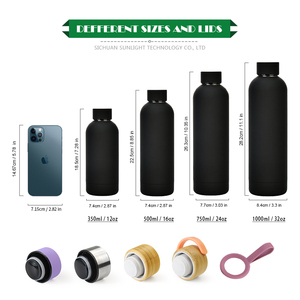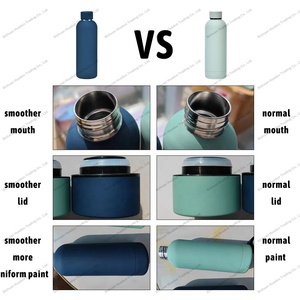
All categories
Featured selections
Trade Assurance
Buyer Central
Help Center
Get the app
Become a supplier

(61715 products available)




















































A flask is a container that is used to hold liquids. There are many different kinds of flasks, each designed with a specific purpose in mind. Some common types of flasks include:
Laboratory flasks:
Laboratory glass flasks are common laboratory apparatus made of glass. They are used for mixing, heating, and storing chemicals. Some laboratory glassware flasks have a tapered neck suitable for sealing with a stopper. Others are designed for measuring volume with marked graduations. Examples of laboratory glassware flasks are round-bottomed flasks, volumetric flasks, Erlenmeyer flasks, and filtering crucibles.
Hip flasks:
These are small, portable containers traditionally used to carry alcoholic beverages. Made from various materials, including stainless steel, leather, and pewter, hip drinking flasks typically have a narrow neck and a secure screw-on or push-button top to prevent leaks. They come in different sizes and designs, ranging from classic and elegant to modern and minimalist. Some leather hip flasks have an OEM custom logo option, allowing for branding or personalization.
Vacuum flasks:
Also known as thermoses, vacuum flask bottles are designed to keep hot liquids hot and cold liquids cold for extended periods. They work by creating a vacuum between two layers of stainless steel, which reduces heat transfer. This type of flask is great for storing coffee, tea, soup, and cold drinks while traveling or outdoors.
Flasks for camping:
Camping flasks are designed to withstand the rigors of outdoor activities. They are typically made of durable materials, such as stainless steel or hard plastics, and are resistant to impact and harsh weather conditions. Camping flasks often feature double-walled vacuum insulation, which keeps drinks hot or cold for long periods, and have leak-proof lids to prevent spills in backpacks or coolers.
Industrial flasks:
Industrial flasks are larger and more robust versions of hip flasks. They are designed to handle and store chemicals in factories and laboratories. Industrial flask manufacturers make them from durable materials like glass, plastic, or metal to ensure they can withstand harsh environments and corrosive substances.
Logo Design:
Flask logo designs are created after extensive research about the brand, its competitors, and the target audience. The logo design is made to be unique and easy to recognize so that it represents the brand's identity. The logo design is made in various formats and resolutions so that it can be used for different purposes, such as print and web.
Color Schemes:
OEM flask color schemes are created to align with the brand's identity and image. This is done by selecting colors that reflect the brand's personality and values. The color scheme is designed to be visually appealing and harmonized so that it creates a pleasant and impactful look. The color scheme is provided in various formats so that it can be used for different applications, such as print and digital media.
Shape and Size Selection:
When designing an OEM flask, one of the primary considerations is the shape and size selection. This is important to ensure that the flask is practical and easy to use. The shape of the flask is designed to be comfortable and convenient for holding and carrying. The size of the flask is determined based on its intended use and target market, ensuring it meets the needs of consumers.
Material and Texture:
The material and texture of the flask are also critical design aspects. This is done to ensure the quality and durability of the flask. The material of the flask is selected based on safety and functionality, such as stainless steel, glass, or plastic. The texture of the flask is designed to be aesthetically pleasing and easy to use, such as matte, glossy, or embossed textures.
Closure and Opening Mechanism:
The closure and opening mechanism of the flask are also important design considerations. This is done to ensure that the flask is leak-proof and easy to open. The closure of the flask is designed to be secure and reliable, such as screw caps, push-button tops, or flip tops. The opening mechanism of the flask is designed to be simple and convenient, allowing for easy filling and cleaning.
Insulation Technology:
If the flask is insulated, the design will incorporate insulation technology. This is done to maintain the temperature of the beverages. Insulation technology can be vacuum insulation, foam insulation, etc. The design of insulated flasks is typically multi-layered, with an insulating layer in the middle to prevent heat transfer.
Custom metal flasks are applicable in several industries and events. They are a perfect promotional product and a gift. Some common usages include the following:
Event giveaways
Custom flasks make great giveaways for events, conferences, or trade shows. They help in brand promotion, creating a lasting impression on potential clients and partners.
Corporate gifts
Companies can gift clients and employees with custom flasks to promote brand awareness and show appreciation. They also give a professional image to the business.
Weddings and parties
Flasks are unique favors for weddings, bachelor parties, or other special occasions. They help commemorate the event when personalized with the date and initials of the hosts.
Sports teams and events
Flasks are great for sports teams, events, or competitions. They boost team spirit when customized with team colors and logos and keep participants hydrated.
Health and fitness industry
Flasks are useful for gyms, fitness centers, or health retreats. They encourage hydration and promote health. They also serve as merchandise for health-conscious customers.
Outdoor and adventure industry
Flasks are essential for hiking, camping, or adventure tours. They are needed for keeping water and other liquids while engaging in outdoor activities. Custom flasks can be offered by outdoor gear shops or adventure companies.
Non-profit and fundraising
Non-profit organizations can use custom flasks as fundraising products or awareness tools. They communicate the mission of the organization when used in events or campaigns.
Understand Target Market and Trends:
OEM flask manufacturers need to know their customers. They should do market research to understand what types of flasks are popular in their target market. Are people concerned about sustainability? Do they want stylish designs? Knowing these trends can help OEMs suggest new flask designs that will attract customers.
Focus on Sustainability:
Consumers care a lot about the environment these days. OEM flask makers should use eco-friendly materials and sustainable production methods. Offer designs that reduce plastic waste or use recycled materials. This focus on sustainability will appeal to customers who want to protect the planet.
Emphasize Customization:
Businesses want to stand out with their products. OEM flask producers should allow clients to customize flasks. Offer options for adding logos, choosing colors, or changing shapes. The more customization choices available, the better clients can differentiate their brands.
Ensure Quality and Safety:
Flasks are used for drinking liquids, so quality and safety are crucial. OEM manufacturers must ensure their flasks pass quality tests. Design flasks to be durable and long-lasting. Use safe materials that won't contaminate drinks. Meeting quality standards keeps consumers safe and builds trust in the brand.
Keep Up with Technology:
Technology is changing fast, and it affects product design. OEM flask makers should stay informed about technological advances. This could include innovations in insulation, materials, or manufacturing processes. Flaps that integrate the latest tech will have an edge over competitors.
Build Strong Relationships with Suppliers:
The supply chain is vital for OEM success. Manufacturers should build solid relationships with suppliers. This ensures a reliable flow of materials needed for flask production. Strong ties with suppliers also enable manufacturers to collaborate on sourcing eco-friendly materials.
Streamline Production Processes:
To boost efficiency, OEMs should streamline production processes. Conduct regular audits to identify areas for improvement. Implement lean manufacturing principles to reduce waste and speed up production. An optimized process means faster time-to-market for new flask designs.
Conduct Regular Quality Inspections:
Quality control is critical in OEM manufacturing. Set up a system for regular quality inspections of produced flasks. Inspections should check for defects in design, materials, and workmanship. Catching quality issues early prevents faulty products from reaching store shelves.
Be Flexible and Adaptable:
The market can change rapidly. OEM flask producers need to be flexible and adaptable. Be ready to modify designs or production runs in response to shifts in customer demand. Having the ability to pivot quickly keeps the business resilient even with market fluctuations.
Q1: How can one ensure the quality of the OEM flask during production?
A1: To ensure the quality of the OEM flask during production, brands can conduct regular quality inspections, set clear quality standards, and collaborate with suppliers who prioritize quality assurance.
Q2: What are the typical minimum order quantities (MOQs) for OEM flask production?
A2: The typical MOQs for OEM flask production vary depending on the supplier and customization level. It's important to discuss MOQs with the supplier before placing an order.
Q3: How long does it usually take to develop an OEM flask from concept to production?
A3: The timeline for developing an OEM flask from concept to production can vary based on factors such as design complexity, tooling requirements, and production capacity. Clear communication with the supplier can help establish realistic timelines.
Q4: What certifications should be considered for OEM flasks to ensure product safety?
A4: Certifications that should be considered for OEM flasks to ensure product safety include FDA approval, BPA-free certification, and other relevant industry standards depending on the geographical market.
Q5: How can one protect intellectual property (IP) when working with suppliers on OEM flask designs?
A5: To protect intellectual property when working with suppliers on OEM flask designs, brands should use non-disclosure agreements (NDAs), register trademarks, and collaborate with suppliers who respect IP rights.